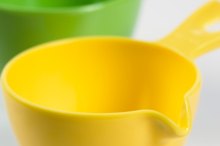How to Calculate Nutritional Intake
In order to determine if you are meeting the recommended dietary allowance, or RDA, of the important macronutrients, carbs, fats, and protein, you need to calculate your nutritional intake. The RDA, defined by the Institute of Medicine, indicates how much of a particular nutrient you need to consume to meet the requirements of 97 to 98 percent of a certain group of people. Keeping a food log for one or more days can help you calculate your daily nutritional intake.
Record the amount of food you eat throughout the day, taking note of the calories, fat, protein and carbohydrates. This information can be found on the nutrition facts label on the package. If you are eating a homemade meal, use the nutrition facts labels for the ingredients. If eating out, you may be able to find the nutrition facts on the restaurant's website.
How to Calculate Fat, Protein & Carbohydrates
Learn More
Add up your total intake for each category at the end of the day. The categories should be calories, fat, protein and carbohydrates. Record these totals.
Multiply the total grams of carbs you consumed by 4 -- that's the number of calories in 1 gram of carbs -- to determine how many of the calories in your diet are from carbohydrates. For example, if you consumed 2,000 calories in a day, with 150 grams of carbs, then 600 of the 2,000 calories, or 30 percent, were from carbohydrates.
How to Figure Out How Much Percentage of Body Fat to Lose
Learn More
Multiply the total grams of fat you consumed by 9 -- the number of calories in 1 gram of fat -- to find the number of calories that came from fat. For example, if you consumed 80 grams of fat, that means that 720 of the total calories you consumed were from fat 1.
Multiply your total protein intake in grams by 4 to determine how many of the calories you consumed were from protein. Each gram of protein has 4 calories 3. For example, if you consumed 50 grams of protein, 200 of your total calories were from protein.
Tips
Be aware of serving sizes when recording your nutritional intake. If the serving size of pasta is 1 cup, but you ate 2 cups, make sure to multiply the information on the nutrition facts label by 2.
You can also use an online nutritional intake tracker, such as the USDA's "SuperTracker."
Warnings
If you have concerns about your nutritional intake, speak with your physician or a registered dietitian.
Related Articles
References
- U.S. Department of Agriculture and U.S. Department of Health and Human Services: Dietary Guidelines for Americans, 2010
- ADA Pocket Guide to Nutrition Assessment, Second Edition; Pamela Charney, PhD, RD, and Ainsley M. Malone, MS, RD, CNSD
- KidsHealth: Learning About Calories
Tips
- Be aware of serving sizes when recording your nutritional intake. If the serving size of pasta is 1 cup, but you ate 2 cups, make sure to multiply the information on the nutrition facts label by 2.
- You can also use an online nutritional intake tracker, such as the USDA's "SuperTracker."
Writer Bio
Dakota Karratti has been writing fitness and health articles since 2010. Her work has appeared in the "Salisbury University Flyer" and "WomanScope NewsMagazine." Karratti has been a Certified Nursing Assistant in Delaware since 2008. She is currently enrolled in The University of Alabama's Nutrition and Food Science BS program.








